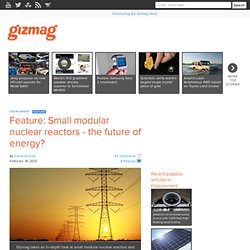

Lockheed Martin's new fusion reactor can change humanity forever. This is outstanding!!
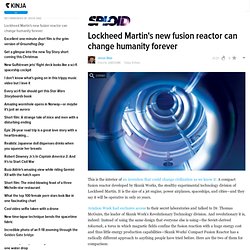
Fusion power at home, or, how small science will defeat big science. Fusion research is known for its huge projects — and its huge lack of tangible success.
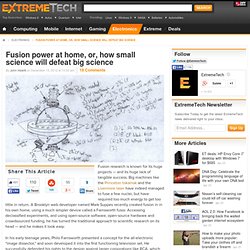
Big machines like the Princeton tokamak and the Livermore laser have indeed managed to fuse a few nuclei, but have required too much energy to get too little in return. A Brooklyn web developer named Mark Suppes recently created fusion in in his own home, using a much simpler device called a Farnsworth fusor. Accessing declassified experiments, and using open-source software, open-source hardware and crowdsourced funding, he has turned the traditional approach to scientific research on its head — and he makes it look easy. In his early teenage years, Philo Farnsworth presented a concept for the all-electronic “image dissector,” and soon developed it into the first functioning television set. Suppes first heard about the Farnesworth fusor from Robert Bussard’s Google Tech Talk.
Can you really create fusion at home? A cautionary note is perhaps in order. NASA’s cold fusion tech could put a nuclear reactor in every home, car, and plane. The cold fusion dream lives on: NASA is developing cheap, clean, low-energy nuclear reaction (LENR) technology that could eventually see cars, planes, and homes powered by small, safe nuclear reactors.
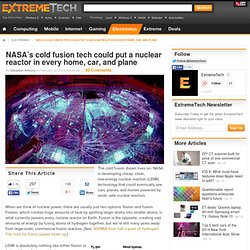
When we think of nuclear power, there are usually just two options: fission and fusion. Fission, which creates huge amounts of heat by splitting larger atoms into smaller atoms, is what currently powers every nuclear reactor on Earth. Fusion is the opposite, creating vast amounts of energy by fusing atoms of hydrogen together, but we’re still many years away from large-scale, commercial fusion reactors.
(See: 500MW from half a gram of hydrogen: The hunt for fusion power heats up.) LENR is absolutely nothing like either fission or fusion. The key to LENR’s cleanliness and safety seems to be the slow-moving neutrons. In Search of Energy Miracles. Some 900 miles to the north, Bill Gates and another Microsoft veteran, Nathan Myhrvold, have poured millions into a company developing a fission reactor that could run on today’s nuclear waste.
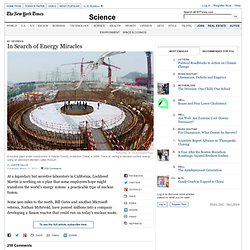
And on the far side of the world, China has seized on discarded American research to pursue a safer reactor based on an abundant element called thorium. Beyond the question of whether they will work, these ambitious schemes pose a larger issue: How much faith should we, as a society, put in the idea of a big technological fix to save the world from ? A lot of smart people are coming to see the energy problem as the defining challenge of the 21st century. We have to supply power and transportation to an eventual population of 10 billion people who deserve decent lives, and we have to do it while limiting the emissions that threaten our collective future. Many environmentalists believe that wind and can be scaled to meet the rising demand, especially if coupled with aggressive efforts to cut waste. Life as a Fukushima clean-up worker – radiation, exhaustion, public criticism. Faced with the invisible threat of radiation, Japan's spooked public has turned workers at the Fukushima Daiichi nuclear power plant into the "visible" enemy of the crisis, according to a psychiatrist who counsels the workers.
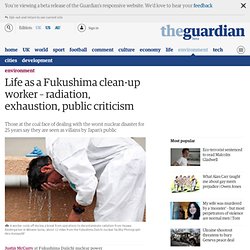
"The workers are at higher risk of radiation exposure, and they are part of a process that will last decades," Jun Shigemura, a lecturer in the psychiatry department of the National Defense Medical College, told the Guardian. "On top of that, they are criticised for being part of [Tepco]. They are not company executives, but they feel a sense of guilt and responsibility, even though they were not the perpetrators. Www.cap.ca/sites/cap.ca/files/article/1700/oct10-opinion-vogt.pdf. Nuclear Fusion: 'This is the Adventure Part of Venture Capital' While eating lunch at a recent energy conference with the usual random selection of delegates and speakers, I asked the co-founder of a leading energy venture capital firm what technology he finds most exciting right now.
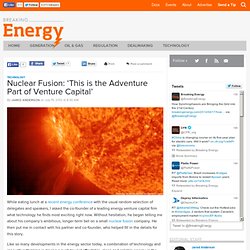
Without hesitation, he began telling me about his company’s ambitious, longer-term bet on a small nuclear fusion company. He then put me in contact with his partner and co-founder, who helped fill in the details for this story. Like so many developments in the energy sector today, a combination of technology and innovative thinking is driving a push toward affordable, clean and reliable energy in the form of nuclear fusion. “Everybody has a right to be skeptical because nuclear fusion is hard, but this has a chance of working,” Chrysalix Energy Venture Capital’s co-founder and CEO, Mike Brown, recently told Breaking Energy in comments about suburban Vancouver based General Fusion.
First new U.S. nuclear reactors in decades approved. Reporting from Los Angeles and Washington — A consortium of utilities in the South won government approval Thursday to construct two new atomic energy reactors at an estimated cost of $14 billion, the strongest signal yet that the three-decade hiatus of nuclear plant construction is finally ending.
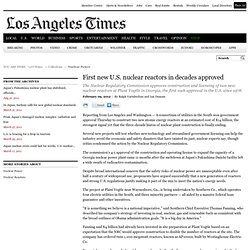
Several new projects will test whether new technology and streamlined government licensing can help the industry avoid the economic and safety disasters that have tainted its past, nuclear experts say, though critics condemned the action by the Nuclear Regulatory Commission. The commission's 4-1 approval of the construction and operating license to expand the capacity of a Georgia nuclear power plant came 11 months after the meltdown at Japan's Fukushima Daiichi facility left a wide swath of radioactive contamination. It may take several years before it becomes clear whether the license approval represents a rebirth of an industry. Ralph.vartabedian@latimes.com ian.duncan@latimes.com.
Feature: Small modular nuclear reactors - the future of energy? This year is an historic one for nuclear power, with the first reactors winning U.S. government approval for construction since 1978.
